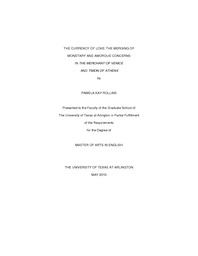
ATTENTION: The works hosted here are being migrated to a new repository that will consolidate resources, improve discoverability, and better show UTA's research impact on the global community. We will update authors as the migration progresses. Please see MavMatrix for more information.
Show simple item record
| dc.contributor.author | Rollins, Pamela Kay | en_US |
| dc.date.accessioned | 2010-07-19T19:54:46Z | |
| dc.date.available | 2010-07-19T19:54:46Z | |
| dc.date.issued | 2010-07-19 | |
| dc.date.submitted | January 2010 | en_US |
| dc.identifier.other | DISS-10639 | en_US |
| dc.identifier.uri | http://hdl.handle.net/10106/4912 | |
| dc.description.abstract | I argue that Timon of Athens and The Merchant of Venice illustrate that money and love can exist within the same exchange system, within which each relationship retains a value based upon an expectation of reciprocity. The terms of reciprocity found in the relationships of these plays is often intertwined through the means of gift exchange and bonds. The exchange of gifts, when involved in the evaluation of a relationship, questions the very nature of an altruistic gift and illustrates further the means by which affection influences monetary exchanges. Furthermore, the quantitative and qualitative exchanges in Merchant and Timon depict the complex notion of value in early modern England. These plays illustrate the reality of life and human exchange--a system within which love and money are continually intertwined and exchanged. | en_US |
| dc.description.sponsorship | Tigner, Amy L. | en_US |
| dc.language.iso | EN | en_US |
| dc.publisher | English | en_US |
| dc.title | The Currency Of Love: The Merging Of Monetary And Amorous Concerns In The Merchant Of Venice and Timon Of Athens | en_US |
| dc.type | M.A. | en_US |
| dc.contributor.committeeChair | Tigner, Amy L. | en_US |
| dc.degree.department | English | en_US |
| dc.degree.discipline | English | en_US |
| dc.degree.grantor | University of Texas at Arlington | en_US |
| dc.degree.level | masters | en_US |
| dc.degree.name | M.A. | en_US |
| dc.identifier.externalLink | https://www.uta.edu/ra/real/editprofile.php?onlyview=1&pid=3143 | |
| dc.identifier.externalLinkDescription | Link to Research Profiles | |
Files in this item
- Name:
- Rollins_uta_2502M_10639.pdf
- Size:
- 368.6Kb
- Format:
- PDF
This item appears in the following Collection(s)
Show simple item record


